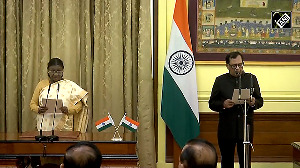What a great World Cup! Hosts South Africa, down and almost out, suddenly have a lifeline thrown thanks to the weather, as the West Indies and Bangladesh share the points at Willowmore Park, Benoni.
Australia, who have vanquished all so far, in Steve Waugh's own words, would miss playing the hosts, as he believes that they are still an excellent team, and the prospect of a South Africa versus Australia final is now a possibility again. However, these are not the only two teams in the World Cup
We cannot discount England even though, after many hours of negotiation deciding not to go to Zimbabwe citing security reasons, they now have a mountain to climb. A lot will depend in their group on the clash of the Asian titans, Pakistan and India. Unable to lock horns in their own backyard for well-documented reasons, they will meet soon for a vital game in terms of qualification.
Despite the fact that they emanate from the same area of the world the two teams could not be more different. The Pakistanis are aggressive, almost haughty, with a tremendous aura of confidence and even an element of brashness, while India are extremely different; a lot calmer, more placid, in the past weaker mentally, but I think that has changed now. Pakistan, bristling with pace; India, with guile. India's much-vaunted batting (currently in disarray) and Pakistan's is also very different. India's, more technically correct; Pakistan's, more frenetic and loose. Both sets of players are very dangerous if they get in. Interestingly, the Australians decimated both teams by bowling meticulous lines, and hit some lusty blows to disrupt their lines and lengths.
The Australians know that if they stick to a plan they would eventually dismiss their opponents. Interestingly, the Australian team members all have 'lap tops' in their bedrooms and John Buchanan sends information and game plans with visuals and analysis to their rooms on a regular basis so that the players can study and visualise both their bowling and batting strategies.
Planning and preparation are almost statutory requisites for all Test sides these days and I am sure that John Wright and Richard Pybus, the respective team coaches of India and Pakistan, will be doing their homework on each other. As importantly, they will need to look at themselves and work out a strategy to prevent the side effects of adrenaline, which will be in rich supply for this contest. Not just the four points up for grabs, but national pride and so much more. Both sides have computerised analysis systems, trainers, coaches, and all the back up, so what is going to make the difference?
During my tenure as South African coach we were able to define real defects in all the players' techniques from the subcontinent although they were easier to expose in South Africa on bouncier pitches than on slow and low ones. Essentially, all Asian-based players are keen to get onto the front foot very early and also close themselves off. This means that they are better leg-side players. Therefore, if the ball bounced and was outside off-stump then they tended to parry at the ball and steer it to slip. Bowling the correct lines usually ensured that the batters could be dismissed in that area and large totals were not forthcoming unless the new ball was seen off.
Currently India are in the worst shape that they can possibly be. Ignominiously bowled out by Holland, decimated by Australia for their lowest score in the World Cup, the side that can boast some of the best batsmen in the world, such as Tendulkar, Ganguly, Dravid and Sehwag amongst others, cannot put together a total worth defending.
The trip to New Zealand has come back to haunt them and is having a dreadful effect on their batting. John Wright will have his work cut out to regain their confidence, and they are going to need it against the much-vaunted Pakistan bowling attack. There will be no respite from Shoaib Akhtar, who bowled one ball at 159 km per hour against the poor Namibians. They will know that Ganguly does not like it short and quick (who does incidentally?), but Ganguly does not play it that well, at least that is the buzz on the circuit.
Wasim Akram has a new lease of life and Waqar Younis is no mug and is captaining pretty well. In fact, probably one of the main reasons that Pakistan have a better record recently is purely because of their seam attack. However, I have to say that they (the Pakistanis) are more vulnerable against spin than they used to be, probably because they never face it these days. So if India could rack up a big score and the pitch takes some turn they have a real chance of beating Pakistan. It will depend very much on the surface.
The pressure on India to perform is huge. This is clearly demonstrated when you read of Indian supporters burning effigies of their previous heroes. Life as a cricketer is no longer simple!
Indeed, in the 1996 World Cup, the Pakistan fans did likewise and a number of the players went abroad to allow things to cool down. Essentially the main difference between Asian and other cricketers is based around temperament. Adrenaline, pressure, often leads to excessive excitement and panic and inexplicable run-outs and shot selection. When India are focused and calm then they do well, as do Pakistan, and this will be the major factor for victory in this game.
Despite all the planning the deciding factor will be more than technical expertise, planning or technology. Passion and pride will be in full attendance. Perhaps the coaches need to impress upon the their teams this great phrase, certainly a favourite of mine, uttered by Ian McGeechan, the Lions rugby coach, on a tour to South Africa: "Bodies in the oven and Brains in the fridge."
In other words, put the bodies on the line for 100 overs -- dive, stop, throw and generally get involved -- but keep a cool head under pressure.
The team closest to this dictum will come out on top in what promises to be a wonderful encounter.
(Gameplan)




